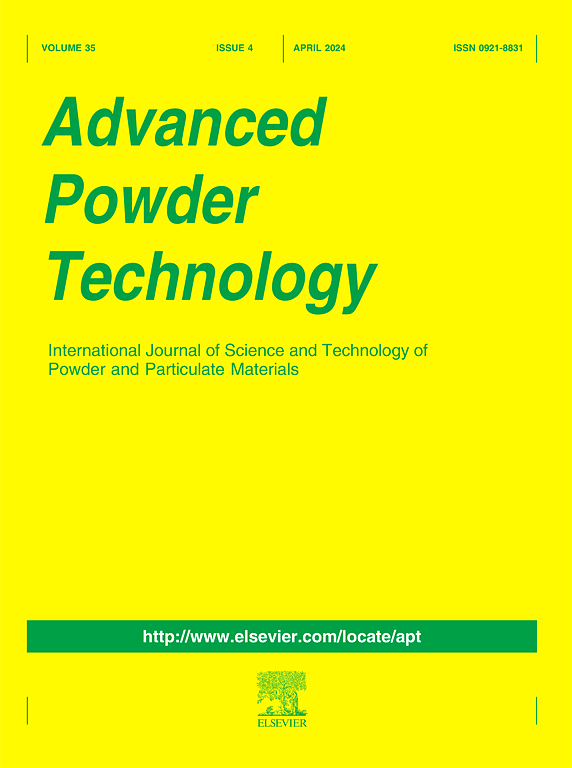散装固体螺旋输送中的周期性磨损建模:通过实验和DEM仿真验证的基于表面轮廓的框架
IF 4.2
2区 工程技术
Q2 ENGINEERING, CHEMICAL
引用次数: 0
摘要
立式螺旋卸船机在港口散货运输中起着至关重要的作用。然而,螺旋管壁的严重磨损仍然是一个主要挑战,通常会缩短其使用寿命并增加维护成本。现有的模型不能准确地预测磨损进程或评估其在不同操作条件下的寿命。在这项研究中,提出了一种新的预测框架,该框架无需现场拆卸或中断操作,即可评估螺旋管磨损。在此框架下,将Archard磨损模型与单颗粒方法和连续介质假设相结合。实验结果和离散元法(DEM)仿真验证了该方法的有效性。在此框架下,将螺旋输送机内颗粒堆积模式划分为四种类型。针对每种类型,提出了相应的周期磨损模型,其预测结果比基于dem的常规预测结果更接近实验结果。参数分析表明,螺杆转速对磨损强度的影响比对物料填充程度的影响更为显著。此外,研究还证实了沿螺杆管的周期性磨损,并且类似的磨损率周期性地发生在与螺杆螺距相等的间隔上。本文章由计算机程序翻译,如有差异,请以英文原文为准。

Periodic wear modelling in bulk solids screw conveying: A surface-profile-based framework validated through experiment and DEM simulation
The vertical screw ship unloader plays a vital role in the transportation of bulk cargo at ports. However, severe wear of screw pipe wall remains a major challenge, often shortens its service life and increases maintenance costs. Existing models cannot accurately predict wear progression or assess its lifespan under different operating conditions. In this study, a novel predictive framework, which did not require on-site disassembly or operational interruption, was proposed to assess screw pipe wear. In the framework, the Archard wear model was integrated with the single-particle method and a continuous medium assumption. Its effectiveness was validated by both experimental results and discrete element method (DEM) simulations. With this framework, particle accumulation patterns within the screw conveyor were classified into four types. For each type, a corresponding periodic wear model was proposed and its prediction results were closer to experimental results than conventional DEM-based predictions. Parametric analysis indicated that screw rotational speed had the more significant impact on wear intensity than the filling degree of materials. Additionally, the study confirmed periodic wear along screw pipe and similar wear rates periodically occurring at intervals equal to screw pitch.
求助全文
通过发布文献求助,成功后即可免费获取论文全文。
去求助
来源期刊

Advanced Powder Technology
工程技术-工程:化工
CiteScore
9.50
自引率
7.70%
发文量
424
审稿时长
55 days
期刊介绍:
The aim of Advanced Powder Technology is to meet the demand for an international journal that integrates all aspects of science and technology research on powder and particulate materials. The journal fulfills this purpose by publishing original research papers, rapid communications, reviews, and translated articles by prominent researchers worldwide.
The editorial work of Advanced Powder Technology, which was founded as the International Journal of the Society of Powder Technology, Japan, is now shared by distinguished board members, who operate in a unique framework designed to respond to the increasing global demand for articles on not only powder and particles, but also on various materials produced from them.
Advanced Powder Technology covers various areas, but a discussion of powder and particles is required in articles. Topics include: Production of powder and particulate materials in gases and liquids(nanoparticles, fine ceramics, pharmaceuticals, novel functional materials, etc.); Aerosol and colloidal processing; Powder and particle characterization; Dynamics and phenomena; Calculation and simulation (CFD, DEM, Monte Carlo method, population balance, etc.); Measurement and control of powder processes; Particle modification; Comminution; Powder handling and operations (storage, transport, granulation, separation, fluidization, etc.)
 求助内容:
求助内容: 应助结果提醒方式:
应助结果提醒方式:


